Sean Connery
As (The One and Only) James Bond
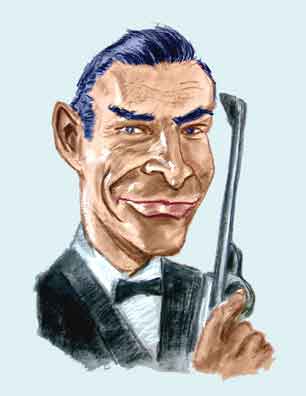
Sean Connery
The One and Only
For those who have never ventured outside their houses in 50 years, own no televisions or radios, and never read magazines or newspapers, this is Sean Connery in his most famous role, that of Ian Fleming's James Bond, British Secret Service Agent 007.
This was actually drawn during an art class (but colored on a computer). It was originally started off having Sean with a wider and higher forehead. But the teacher suggested making the forehead smaller and more narrow, so as to accentuate Sean's longer lower face.
That seemed to work OK, although other caricaturist do tend to exaggerate Sean's forehead and receding hairline. It's not widely known (well, not that widely known), but when he appeared in the early Bond movies, Sean's frontal was already precipitously approaching his occipital. To bring Sean's appearance in line with Ian's idea of what Bond should look like, some - ah - "special effects" were needed. The vulgar would call it a toupee.
There's endless debate on who the "real" James Bond was. At one time or another virtually every famous (or infamous) spy who was associated with England has been suggested. All the discussion is entirely speculative, of course, and although it's a fun game, really doesn't tell us much other than James Bond is supposed to be a British spy.
But in any case, there's not much doubt that Ian created James Bond heavily in his own image - or at least in Ian's image of what he would like to have been. The two gentlemen could indeed have exchanged vitae. During World War II Ian was in Naval Intelligence (like Bond) where he rose to the rank of commander (also like Bond). Similarities between the creator and the created are particularly evident in their personal likes and dislikes. Ian liked scrambled eggs (as did Bond), wore short sleeve shirts (a favorite Bond item of apparel), drank 7 to 10 strong drinks a day including vodka martinis shaken not stirred (the perennial Bond drink), smoked 60-70 Moreland Special Blend cigarettes a day (Bond smoked at least 60 a day), enjoyed high stakes gambling (Bond always won, Ian sometimes lost his shirt), distrusted people who shaved twice a day (a two-a-day shaver in a Bond book is always a villain), loved golf (Bond was a respectable nine handicap), and of course, had a penchant for the ladies. It's been pointed out by more than one author that except for his fondness for the fairer sex (which did him no major harm), Ian's lifestyle centering on alcohol, cigarettes, high fat and cholesterol-laden foods, and late night partying would have been fine if he had always remained in his thirties. But it wasn't so good for a man who wanted to survive beyond his fifty-sixth year, which of course, Ian didn't.
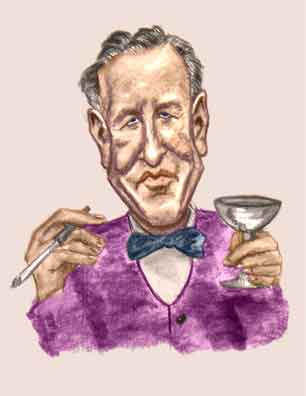
Ian Fleming
In His Own Image
All right. Was Ian a spy? Well, he was in the Intelligence Service, yes, and if that makes you a spy, then Ian was a spy. But if to be a spy you need to be an actual operational agent, then he wasn't. During the war (1939 to 1945) Ian was assistant to the director of Naval Intelligence where his job (obviously) was assisting the director of Naval Intelligence. Although by no means just a desk job, his work did not put him directly in the field. But he was involved in planning and testing the feasibility of certain operations and his acquaintances with real behind-the-lines-spies sometimes led to him fantasizing himself into a bit more heroic picture than the facts merited. Given 007's duties in the M16 hierarchy it's interesting that Ian would sometimes admit (albeit a bit shamefacedly) that he had always wished he had killed in the line of duty. But this was something that he, unlike his literary creation, never did.
If you want to know more about Ian, there's been several biographies published. None of these have been particularly good sellers, mostly because despite the Bondian-picture on the first paperback edition, Ian Fleming was not James Bond. His personal life, although not necessarily dull, was not one of high adventure. But he certainly got around. In his early twenties he was the Moscow correspondent for Reuters for a few years, and then worked for his family's bank and as a stock broker. After World War II he became a foreign news editor for several English newspapers and bought a house in Jamaica (the famous "Goldeneye"). If you know anything about the pay of newspapermen in those days, then you know Ian's international jet-set lifestyle with leisure to bask in the Caribbean and write novels had to have been at least in part supplemented by his well-to-do family
Oddly enough, if you're looking for Ian's private letters and manuscripts, plus interviews by people who knew him, you don't travel to the libraries of his old alma mater of Sandhurst (where he wasn't a very good student) or to one of the English Universities. You go to the American Midwest where his papers and manuscripts (yes, the Bond novel manuscripts) are held by the University of Indiana at Bloomington.
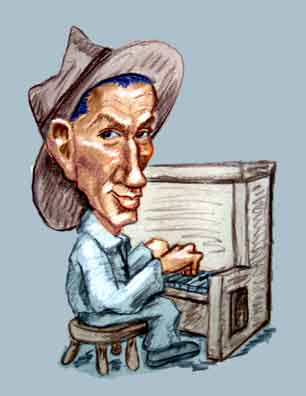
Hoagy Carmichael
The Original James Bond?
As far as what James was supposed to look like, Fleming's own mental image of Bond arose, ironically, from the appearance of a then well-known American. In his eye, Fleming saw Bond looking like the songwriter, Hoagy Carmichael, and some places you'll read that Fleming originally wanted Hoagy to play the part. Maybe, but Fleming did go on record that he thought David Niven or his friend, Noel Coward would be good for the part. But Hoagy was also an actor and appeared in a number of films and television shows and even made a guest appearance in "Rawhide. But he was really at his best when he was acting more or less as himself, that is, a thin middle aged guy playing "Stardust". So it's not likely he would really have been the best choice for a suave, smooth (and British) secret agent. In any case, by the time Bond came on screen Hoagy was about a quarter century too old and had developed his craggy, weathered look.
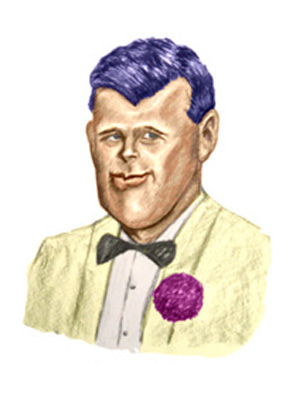
Barry Nelson
The Original James - or Rather "Jimmy" Bond
Despite what has been written, Bond did not first appear on screen in the surprise hit of 1962, Dr. No. Nor was Sean Connery the first actor to portray the sophisticated secret agent. In 1954, only a year after the book was published, Casino Royale was made into a one-hour television drama. Shot for a US audience, the show starred actor Barry Nelson, an able but relatively little known actor, perhaps best known for playing the husband in Twilight Zone's classic "Stopover in a Quiet Town". But here Barry plays "Jimmy" Bond, an American (yes, American) spy who is partnered with a British secret agent, Clarence (yes, Clarence) Leiter. The first Bond girl was played by Linda Christian, who in real life was married successively to Tyrone Power and Edmund Purdom (who's big claim to sort-of fame was to star in the swords and sandals extravaganza "The Egyptian"). Linda's role was that of Vesper Mathis, an androgynous combination of two characters from the book, Vesper Lynd (the first first Bond girl) and René Mathis, Bond's (male) friend from the French Deuxième Bureau. Why the scriptwriters felt the need to change the names is anyone's guess. I mean, Clarence is not a better name than Felix, and Lynd is a heck of a lot better name for a Bond girl than Mathis. But as in the book, "Jimmy" bests Le Chiffre, the notorious enemy agent, at cards. And who played Le Chiffre, and so became the first on-screen Bond villain? None than movie super-baddie Peter Lorre.
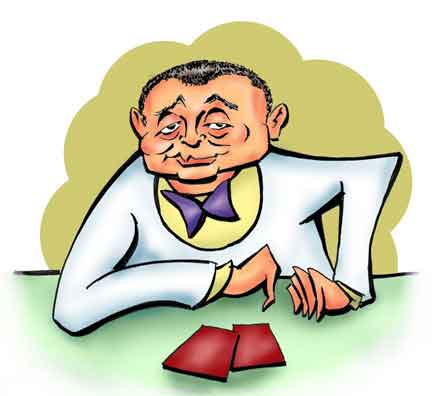
Peter Lorre
The Original Bond Villain
The original TV show was long lost until the 1980's when a film collector found a 16 mm print in a flea market. It was issued on video but it didn't become widely available until it was released as a bonus track with the DVD of the 1967 Casino Royale - the spy-spoof that starred David Niven, Peter Sellers, Woody Allen (whose character was also named "Jimmy" Bond), Ursula Andress (five years after Dr. No), Orson Welles, and Deborah Kerr to name a few. The TV Casino isn't really a bad show at all and is vastly superior to it's 1967 namesakewhich has to be one of the most ridiculous, stupid, and absurd movies ever produced.
In the TV version there are deferments to the time and technology. Although the acting is a bit stylized (typical of 1950's television), all actors are quite good, particularly Peter Lorre. Of course, in the famous torture scene Jimmy is not bound naked to a chair where Le Chiffre whacks him in the ---, well, in the body parts that the Romans's called "the parts that are held in reverence. Instead Le Chiffre had his hoodlums tie Jimmy up in a bathtub with his feet hanging over the edge. Then they removed his shoes and mashed Jimmy's toes with a pair of pliers. But even there they didn't show the actual mashing. It was off screen and you just saw Barry - that is "Jimmy" - writhing in anguish. Other concessions is that Le Chiffre doesn't get shot by a Russian agent. He's shot by Jimmy but not fatally. As the show ends, Jimmy's going to have the cops come take Le Chiffre away.
As befitting the now established tradition of trashing something before you know anything about it, the new 2006 version of Casino Royale was pilloried before it was released. The main objections seemed to be that the new Bond, Daniel Craig, didn't have the established Bond look a la Connery, Moore, Dalton, or Brosnan. He certainly didn't look like Hoagy Carmichael (or maybe the problem was he did look too much like Hoagy). There was even talk among Bond aficionados of boycotts and protests. But when people actually saw the film, opinion changed, and the movie - and Daniel - got rave reviews.
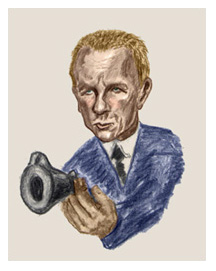
Daniel Craig
Too Much Like Hoagy
As in all Bond movies starting with "Diamonds Are Forever", the new Casino script takes major liberties with the plot of the novel. But at least they did keep the famous torture scene in. ("Again the upward jerk of the wrist, and again Bond's whole body writhed and contorted.") It was indeed rendered on-screen in a most masterful manner and prompted one (male) viewer to say, "I was ready to confess after the first whack."
Naturally Casino was adapted to fit modern (again largely American) tastes. As always, Bond had to be be in his thirties, so his birthyear was upped to 1968, rather than the canonical date of 1924. (Can't have an octogenarian 007, can we?) And of course, Bond plays poker, Texas Hold-em, not Baccarat as in the book. This may seem a travesty to all Bond purists since a suave, debonair secret agent should gamble only in suave debonair Continental manner. But read the books, and you'll learn the literary Bond did occasionally indulge in - and sometimes lose at - high stakes poker.
Over the years, Bond has inevitably undergone modernization. He still drinks, but never in excess, and he quit smoking long ago. Although he still likes the ladies, he is for equality all around, and he has no problems that his boss, M, is a woman. Contrast that to the literary Bond who each day smoked sixty specially blended high nicotine cigarettes (with the three gold rings) and drank at least half a fifth of hard liquor, fiddled around with other men's wives several times a week, and grumped that women ever got the right to vote.
We can't neglect the Bond girls, of course, and Ursula Andress is often cited as the first of Bond's on-screen amoreuse. Now it was true she was the first Bond girl to have her voice dubbed in, but even discounting Vesper "Mathis" in the television Casino, she wasn't the first screen Bond girl. That honor falls to Eunice Gayson playing the delectable Sylvia Trench, and who appears in the opening scene of Dr. No even before we see Sean. Eunice later shows up at James' apartment, uninvited but not unwelcome. After she practices a bit with Bond's putter, she and James have a brief conversation - "You have to leave immediately?", "Almost immediately" - before they fade to black.
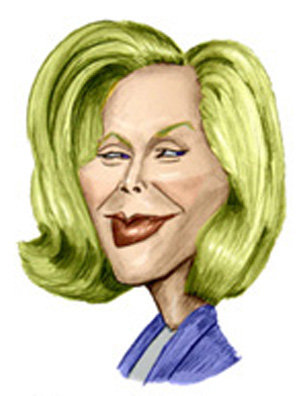
Honor Blackman
The Best Bond Girl when she played - ah - "Miss" Galore
But the hands down best of the Bond girls has to be Honor Blackman in Goldfinger, who played her character at the refreshingly mature age of 37 (three years older than Connery). Not only does Honor knock Bond flat on his face and toss him around in a barn, but her character had to have the most unforgettable name in cinematic (or literary) history. The truth, though, is the censors were in a panic over the name and decided to rechristen Honor's character as "Kitty" Galore. The point, of course, is the name is simply a joke, and changing the first name would completely ruin the point of the last. What kept the name intact was a visit from royalty (an ironical development since Honor advocates abolition of the monarchy). During the shooting, Prince Phillip visited the set and was photographed standing next to Honor. Once the picture appeared on the front page of the dailies with the caption "Pussy and the Prince", the name had to stay.
So after more than half a century, James Bond remains a fixture of world culture. The public is more than happy to have an ever changing face for their favorite secret agent and have him adopt personas and politics to fit the times. The villains and girls also change, but 007 keeps using his license to kill for truth, justice, and the American ----, well, for the British way.
Still when you get down to it, there's only one One and Only James Bond, and that's Sean Connery. It's unlikely any of the later Bonds would disagree. Of course, Sean is now Sir Sean one of filmdom's benighted icons. It's really ironic with knighthoods being handed out only at a slightly slower rate than sainthoods that only 50 years before Sean was born, lowly actors and other (ptui) entertainers were considered unworthy for such an honor.
All right, then. Who was the first actor to be knighted and when?
That is an exercise left to the reader - and perhaps another caricature of someone nobody knows.